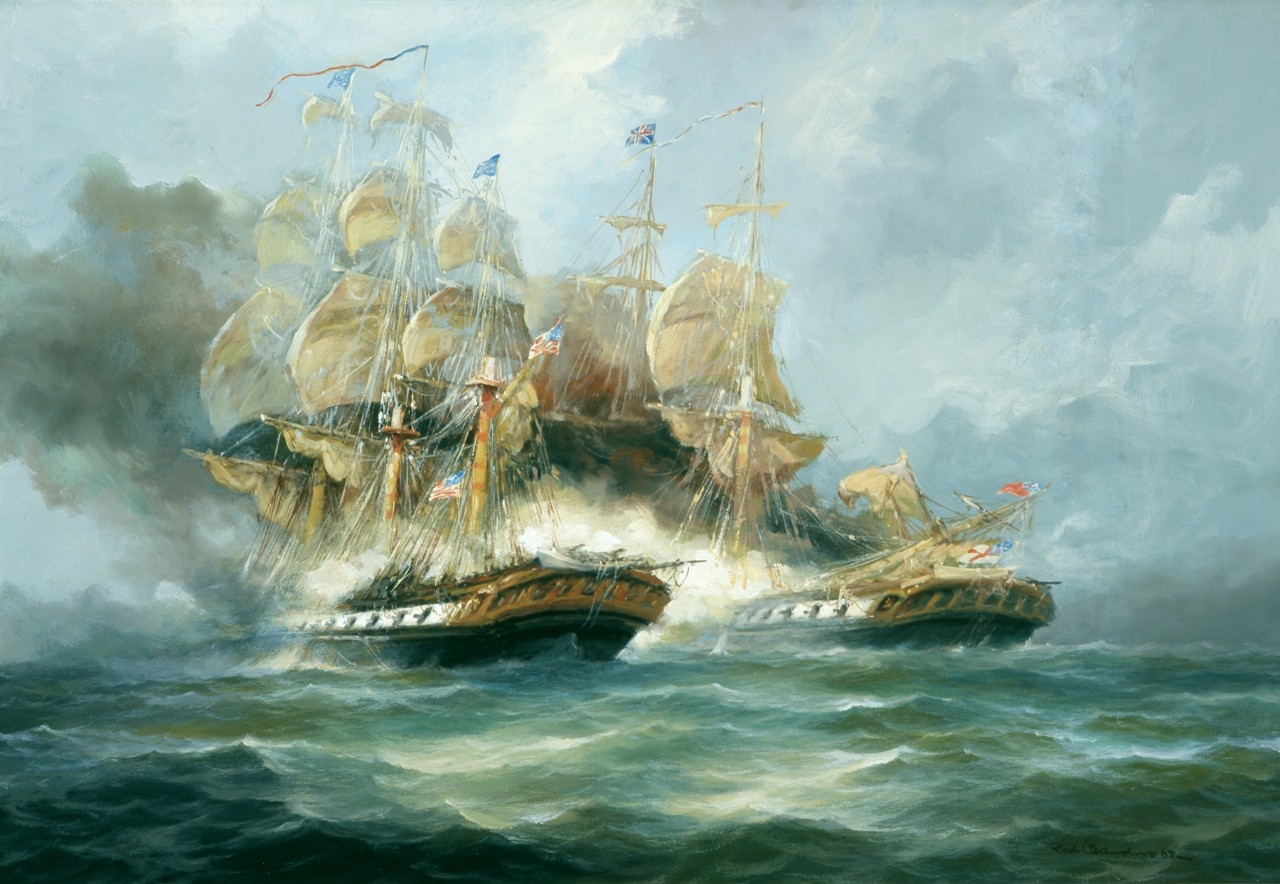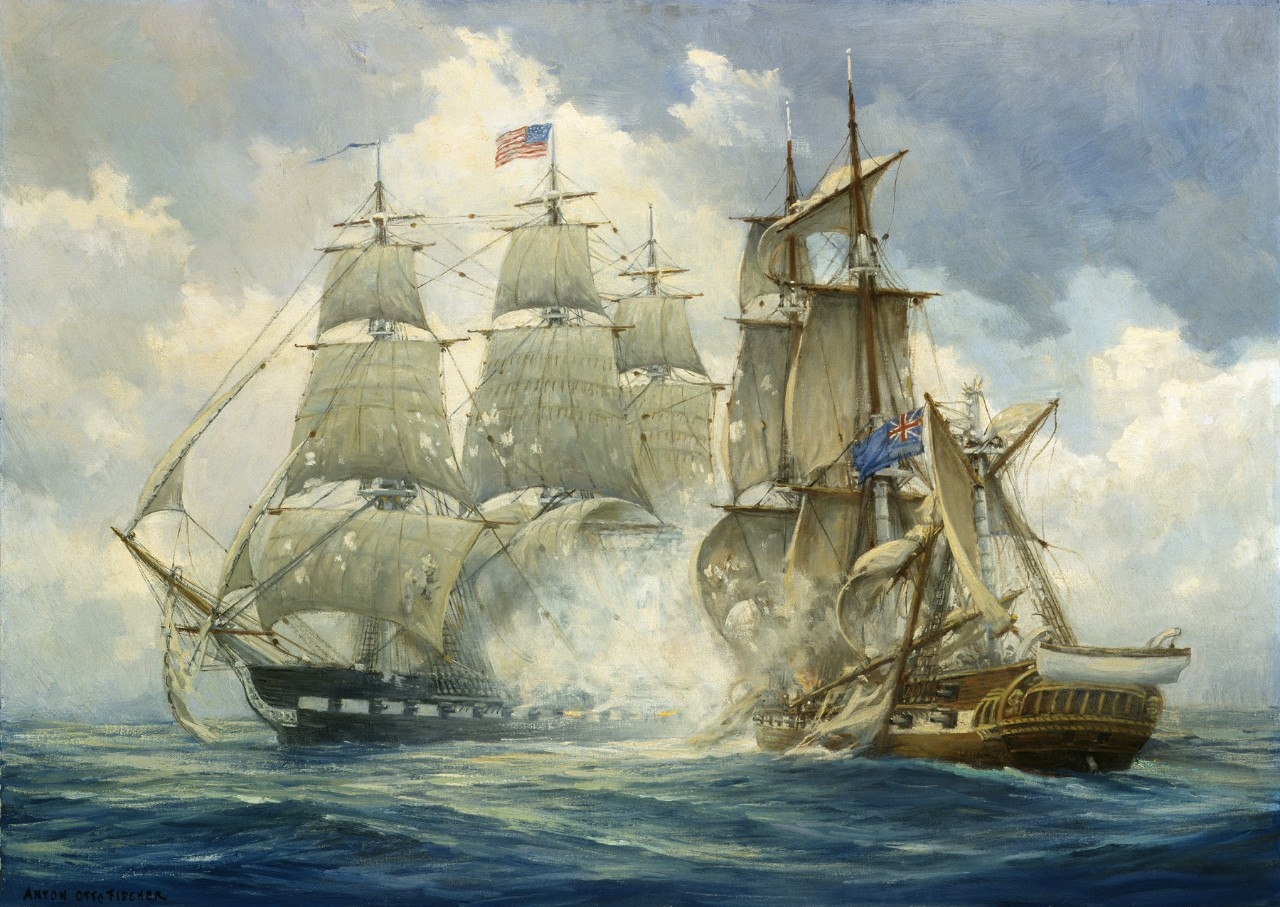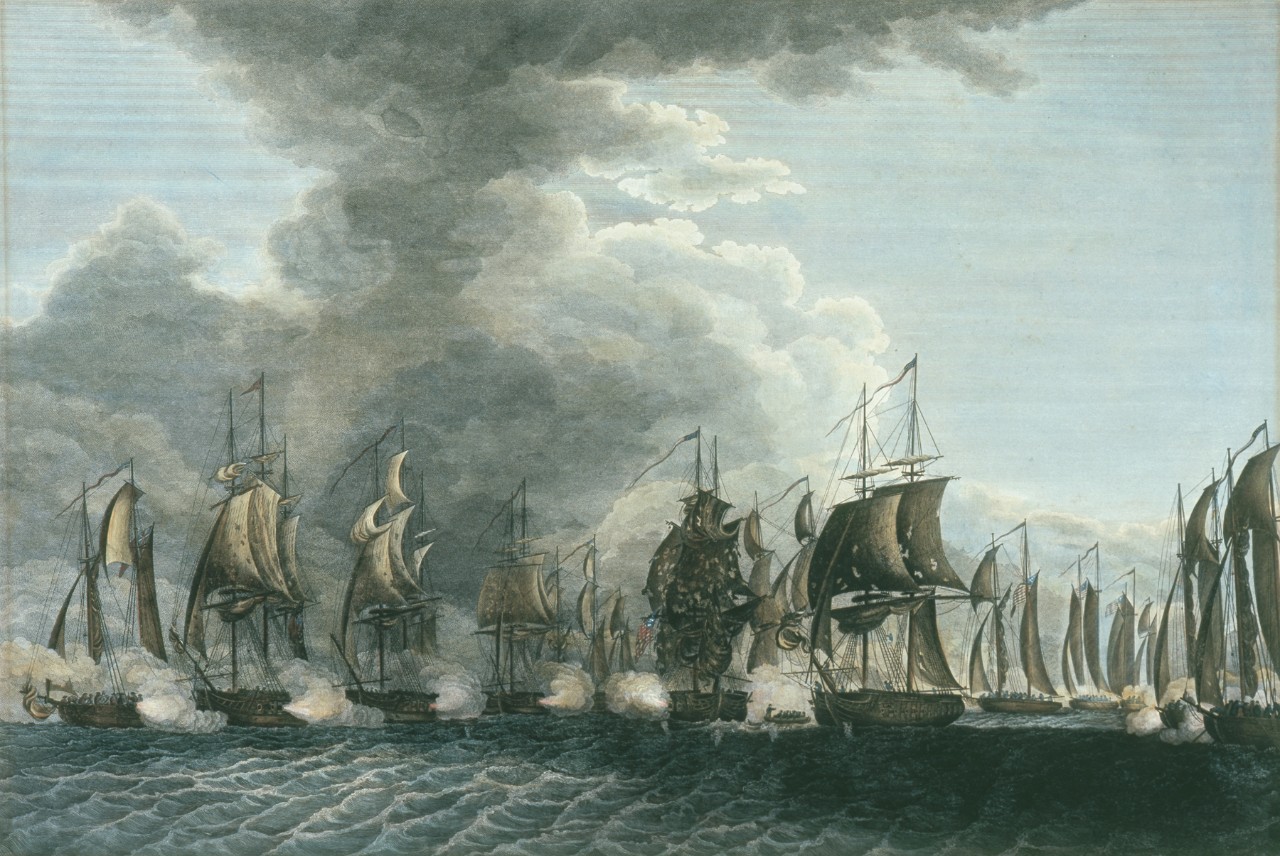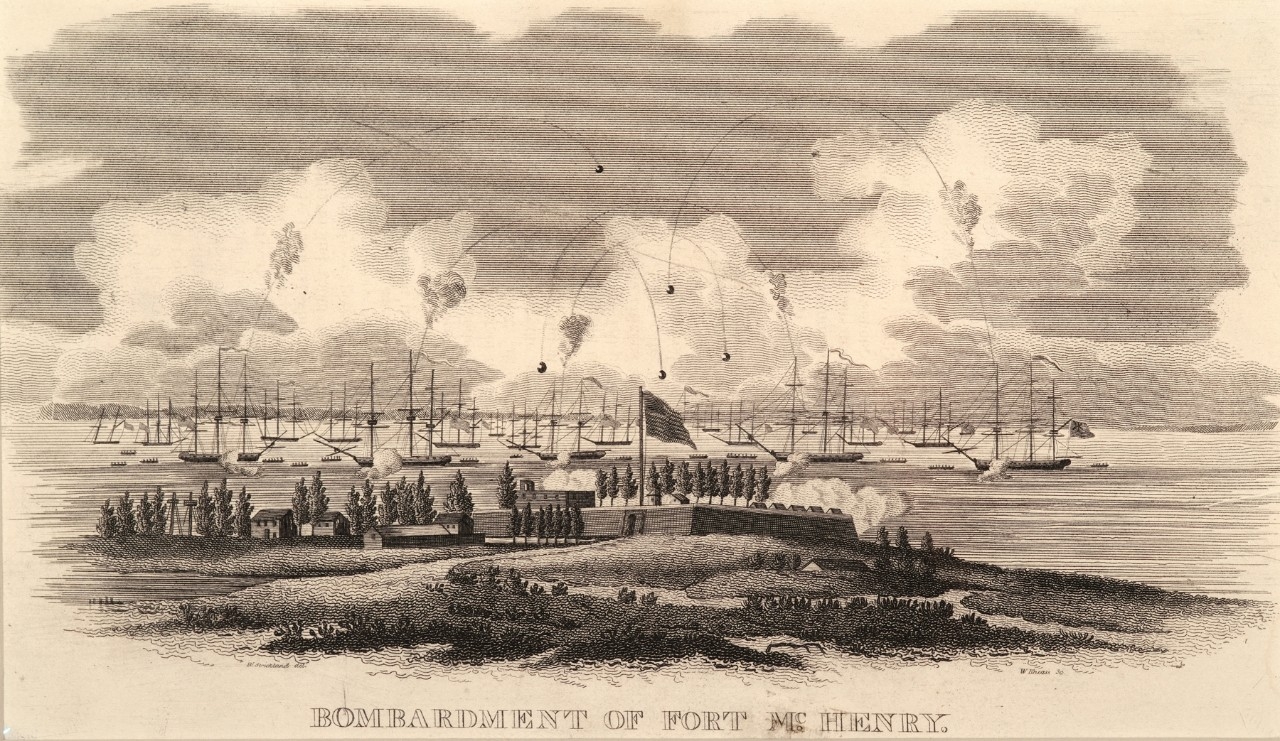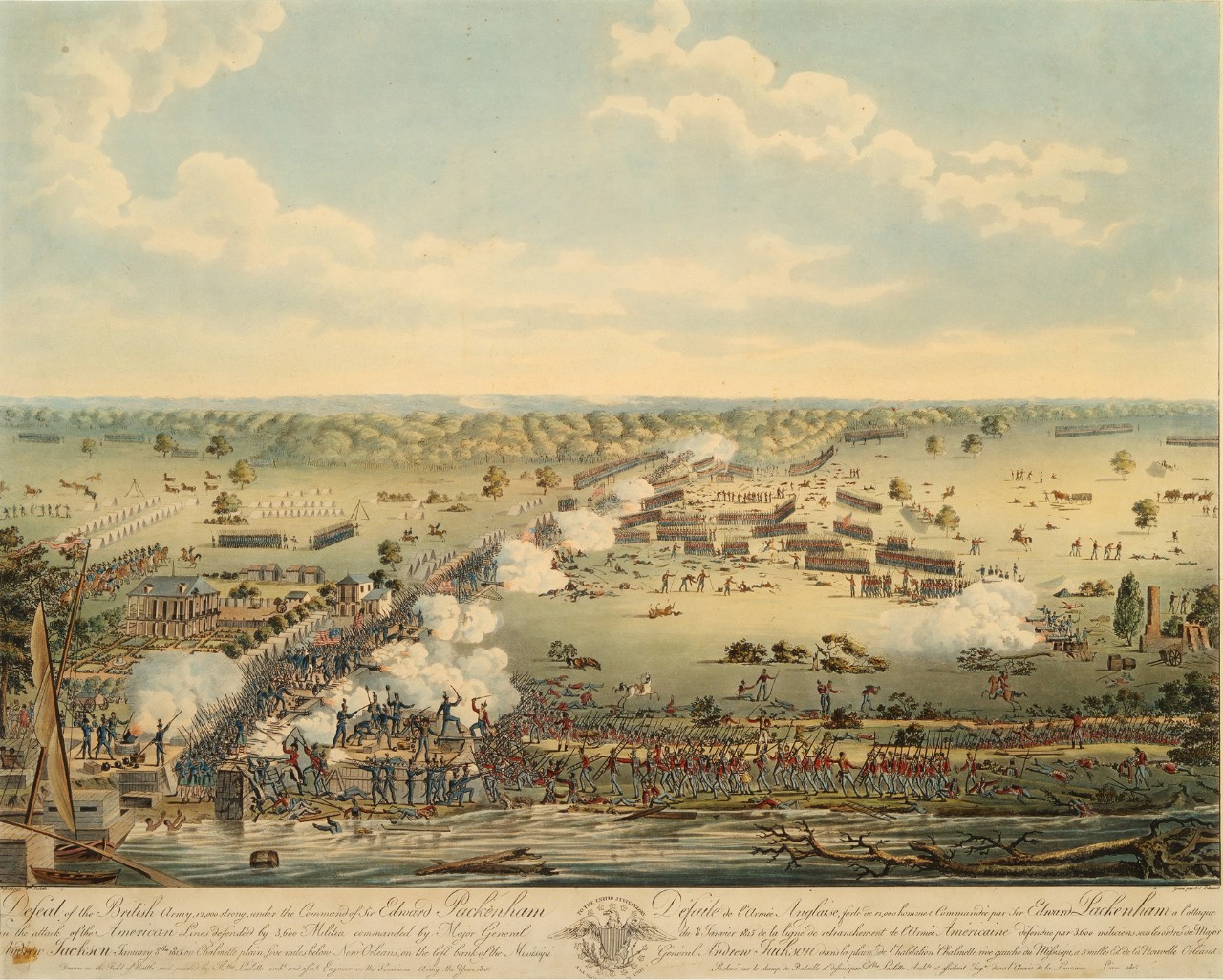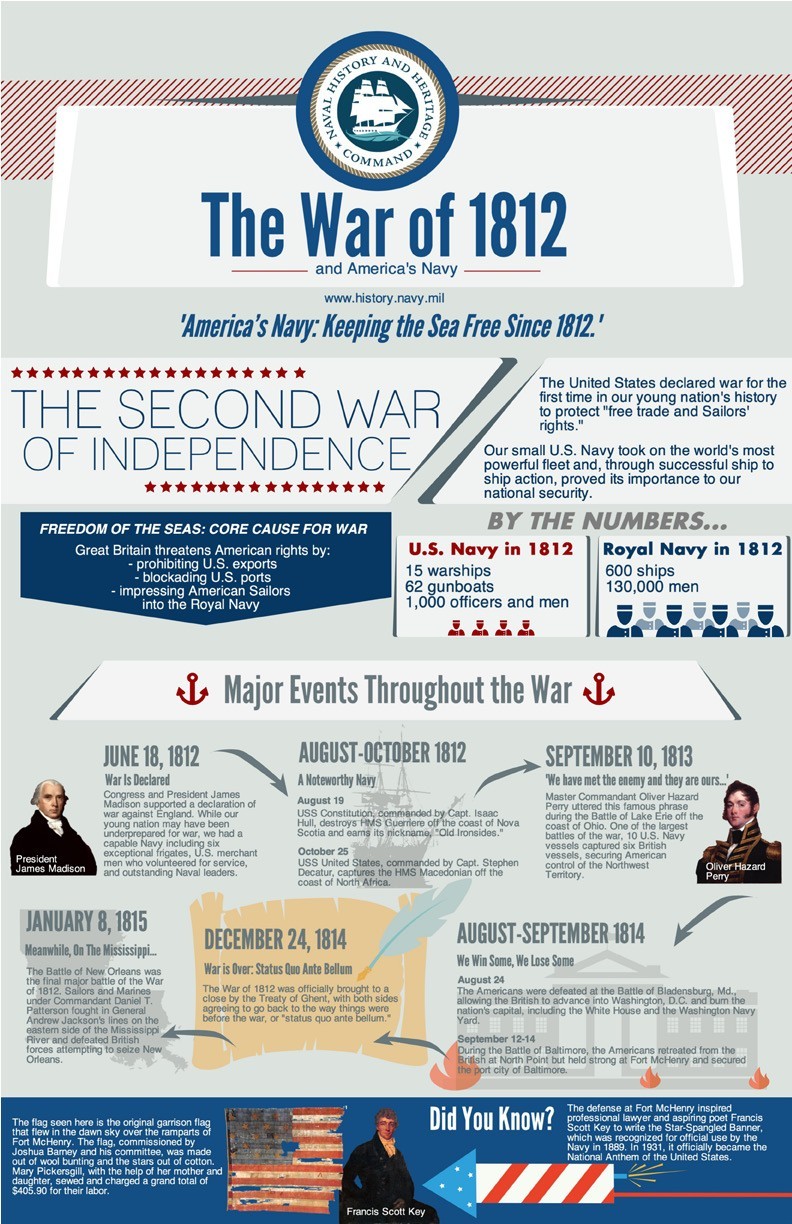War of 1812
1812–1815
On 18 June 1812, the United States formally declared war on Great Britain due to that nation’s continued attempts to restrict trade on the high seas, the Royal Navy’s impressment of American seamen, and the United States’ desire to expand territory. During the War of 1812, fighting on land and at sea took place in several theaters of operations to include the Old Northwest (Ohio, Illinois, Indiana, Michigan, Wisconsin, and Upper Canada), along the river corridors of the Niagara, St. Lawrence, and Lake Champlain-Richelieu, along coastal Maine, in the Chesapeake Bay, on the Gulf Coast, and on the high seas. In the first several years of the war, in contrast to the setbacks experienced by U.S. land forces, the American Navy secured notable victories in the Atlantic and on the Great Lakes, while Britain was forced to concentrate its efforts on the ongoing war with France. However, when French Emperor Napoleon Bonaparte’s armies were defeated in April 1814, Britain turned its full attention on the United States. On 24 August 1814, after defeating American forces at the Battle of Bladensburg, British troops marched into Washington, DC. There, they set multiple government buildings, include the Capitol and the White House, on fire. Commodore Thomas Tingey, commandant of the Washington Navy Yard, saw smoke rising from the Capitol and ordered the strategically valuable yard burned to prevent it from falling into enemy hands.
Although, a U.S. Navy squadron soundly defeated a British flotilla on Lake Champlain during the 6–10 September Battle of Plattsburgh, New York, America’s fortunes remained uncertain as the British set their sights on the vital seaport of Baltimore, Maryland—the third-largest American city at the time. On 13 September 1814, British warships began a 25-hour bombardment of Fort McHenry. However, facing determined U.S. resistance, British warships began withdrawing from the Chesapeake Bay on the following day.
Meanwhile, peace talks, originally started that August, continued at Ghent (modern-day Belgium). On 24 December 1814, the Treaty of Ghent was signed by delegates from both countries and was ratified by the U.S. Senate in February 1815. Neither Great Britain nor the United States lost any territory or surrendered any rights. Indigenous nations, many of which had sided with the British, were unable to recover any lost territories and continued to face additional loss of land to settlers expanding westward. The British made no concessions on maritime issues and retained Canada. However, the United States vindicated its sovereignty and earned international respect for having fought the powerful British Empire to a strategic draw. As word of the treaty was slow to reach North America, several land battles (notably the Battle of New Orleans in January) took place after the treaty had been signed. The war’s last naval engagement (the capture of a British merchant vessel by sloop-of-war USS Peacock off Java) occurred as late as 30 June.
*****
Significant Naval Engagements and Related Land Operations
1812
- 23 June: An American squadron, led by frigate President, engaged HMS Belvidera, but after a prolonged fight, the British frigate managed to escape. Afterward, Belvidera brought word of American hostilities to British officials in Halifax, Canada.
- 15 July: After four days underway from New York, the brig Nautilus, commanded by Lieutenant William Crane, encountered a British squadron consisting of frigates Shannon, Guerriere, Belvidera, and Aeolus, and ship-of-the-line Africa. After a prolonged chase, the British forced Nautilus to surrender.
- 19 August: After narrowly escaping a British squadron in July, U.S. frigate Constitution, commanded by Captain Isaac Hull, defeated HMS Guerriere. During the battle, British cannonballs were seen rebounding from Constitution’s sides, earning the ship the nickname “Old Ironsides.”
- 25 October: Cruising between Azores and Cape Verde Islands, U.S. frigate United States, commanded by Captain Stephen Decatur, Jr. defeated British frigate Macedonian in a two-hour battle.
- 29 December: Off the coast of Brazil, Constitution, commanded by Commodore William Bainbridge, defeated HMS Java in a fierce three-hour battle. Java suffered heavy damage and had to be burned.
1813
- 4 February: British mounted the first of many seaborne raids in the Chesapeake Bay region.
- 24 February: While cruising off the coast of South America, brigantine Hornet, commanded by Master Commandant James Lawrence, immobilized British sloop Peacock in a relatively short battle. While transferring British prisoners of war to Hornet, Peacock suddenly sank, killing nine British and three American sailors.
- 1 June: As the powerful British Royal Navy blockaded many U.S. ports, frigate Chesapeake managed to escape from Boston Harbor and engaged HMS Shannon. During a bloody 15-minute battle in which 156 Americans were either killed or wounded, Chesapeake surrendered. “Don’t give up the ship,” uttered by Captain James Lawrence of Chesapeake, who was mortally wounded during the battle, became a powerful rallying cry for the U.S. Navy.
- 10 September: After a decisive three-hour engagement with a British flotilla, a U.S. Navy squadron commanded by Master Commandant Oliver Hazard Perry secured Lake Erie.The Battle of Lake Erie allowed U.S. commanders to move supplies by water in the Old Northwest. Reporting the victory, Perry wrote, “We have met the enemy and they are ours….”
1814
- 28 March: The Royal Navy defeated American frigate Essex. The ship had sailed in January to the neutral waters of Valparaiso, Chile, but became trapped in harbor for six weeks by two British frigates. Determined to get out on the open sea, Captain David Porter set sail, but a heavy squall disabled the ship, forcing it to return to harbor. Ignoring the neutrality of the harbor, the British attacked the disabled ship. After two hours and the loss of 155 men, Essex surrendered.
- 24 August: The Battle of Bladensburg and capture of Washington, DC. The British landed 4,300 soldiers, sailors, and marines near Benedict, Maryland, and marched toward the American capital. American militia and some U.S. Army regulars attempted to stop the British force, but were unsuccessful. At Bladensburg, Captain Joshua Barney and approximately 500 sailors and Marines manned artillery and provided the only strong resistance to the enemy. Ultimately, the British occupied Washington and burned most of the public buildings, including the Capitol and White House. The Washington Navy Yard was burned to prevent its capture by the British.
- 11 September: During the first week of September, the British marched toward Plattsburgh, New York, to seize territory in Upper New York. However, on 11 September, the U.S. Navy defeated a British squadron on Lake Champlain. Although British land forces outnumbered the Americans two to one, British commanders abandoned the land attack for fear that the U.S. Navy might ferry troops north and cut off their line of retreat. The British subsequently withdrew.
- 12–14 September: After burning Washington, DC, the British returned to their ships and proceeded up the Chesapeake Bay toward Baltimore. After suffering heavy casualties in a victory over American militia at North Point, Maryland, British troops proceeded to the outskirts of Baltimore, but found the city too well defended. The Royal Navy bombarded Fort McHenry, at the mouth of Baltimore Harbor, for 25 hours, but the fort’s defenders prevailed and the British fleet withdrew. American lawyer Francis Scott Key, who witnessed the battle, was inspired to write a stirring poem, “The Defence of Fort McHenry.” The poem was later set to music and titled “The Star Spangled Banner.” In 1931, Congress named the song the National Anthem.
- 24 December: British and American delegates signed a peace treaty in Ghent (present-day Belgium). Although the Treaty of Ghent ended the War of 1812, it took nearly two months for the news of the treaty to reach the United States.
1815
- 8 January: After three preliminary engagements and naval skirmishes in the waters off New Orleans, the British launched a major assault against General Andrew Jackson’s army south of the city. During the Battle of New Orleans, the U.S. Army, militia, and gun batteries manned by U.S. Navy sailors repulsed British forces, who suffered heavy casualties with more than 2,000 wounded, killed, or captured. It was the last major land battle of the War of 1812.
- 15 January: After a duel with HMS Endymion, U.S. frigate President was captured off the coast of New York. Commodore Stephen Decatur, Jr. and the crew were made prisoners and taken to Bermuda.
- 17 February: News of the Treaty of Ghent reached the United States on 14 February, and the United States Senate unanimously approved it two days later. President James Madison signed the treaty the following day.
- 20 February: After it had previously slipped out of Boston and evaded a British blockading squadron, Constitution, commanded by Captain Charles Stewart, encountered a small British frigate and corvette off the Madeira Islands. During the night battle, Constitution managed to outmaneuver the British ships and forced them to surrender. Although HMS Levant was retaken on 12 March by a pursuing British squadron, HMS Cyane reached U.S. shores as a prize.
- 30 June: In the last naval engagement of the war, sloop Peacock captured East India Company brig Nautilus. The captain of Peacock, Lewis Warrington, did not know the war had ended even though British officers onboard Nautilus assured him that a peace treaty had been signed.
War of 1812 in a Snapshot
Suggested Reading
- The Naval War of 1812: A Documentary History
- U.S. Navy’s Six Original Frigates
- Age of Sail
- The Naval War of 1812 by Theodore Roosevelt
- The Capture of Chesapeake
- The Battle of Lake Champlain
- Constitution in the War of 1812
- USS Constitution’s Battle Record
- Constitution Sailors in the Battle of Lake Erie
- The Defense and Burning of Washington in 1814: Naval Documents of the War of 1812
- USS Ticonderoga in the Naval Battle of Plattsburgh (1814)
- Precisely Appropriate for the Purpose: Essay on James Lawrence
- Officers of Peculiar Skill: Petty and Forward Officers of the U.S. Navy, 1797–1860
- Hurricanes and the War of 1812
- Navy Regulations, 1814
- The Constitution Gun Deck
- The Constitution Fighting Top
- Battle of Lake Erie: Building the Fleet in the Wilderness
- USS Constitution: The War of 1812 Commemoration Stamp
- Museum Tea Party Commemorates Treaty of Ghent, War of 1812
- Against All Odds: U.S. Sailors in the War of 1812 (24 MB PDF download)

